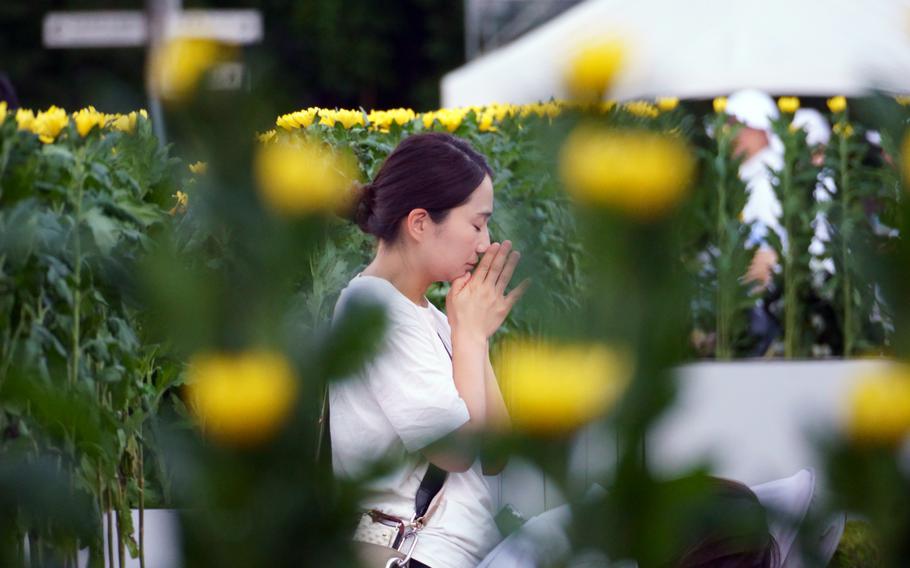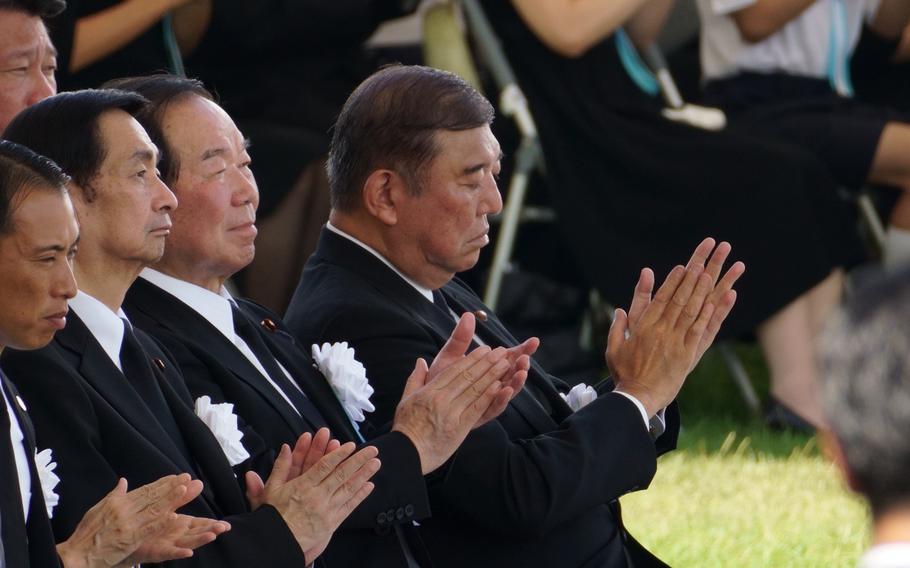
People line up to pay their respects at a cenotaph for atomic bombing victims at Peace Memorial Park in Hiroshima, Japan, Aug. 6, 2025. (Akifumi Ishikawa/Stars and Stripes)
HIROSHIMA, Japan — More than 55,000 people standing in Peace Memorial Park bowed their heads at 8:15 a.m. Wednesday, marking with silence the precise moment that the U.S. military dropped an atomic bomb on this city 80 years ago.
For one minute, the only sounds were the drone of cicadas and the rhythmic tolling of the park’s Bell of Peace.
This year’s annual Peace Memorial Ceremony drew visitors from across the globe to honor those who died in the Aug. 6, 1945, bombing that claimed the lives of more than 140,000 people.
Hiroshima Mayor Kazumi Matsui and representatives of the bereaved families opened the ceremony with a ritual offering of water to the victims and a ceremonial update to the registry of names stored in the park’s cenotaph.
Nearly 5,000 names have been added to the list since last year, bringing the registry’s total to 349,246. There is also a separate list of unidentified victims.
Doves were later released as family members and hibakusha — the term used for survivors of the Hiroshima and Nagasaki atomic bombings — watched.
The number of remaining hibakusha fell below 100,000 this year, according to Japan’s Ministry of Health, Labor and Welfare, with the average age of survivors at just over 86 years old.
Matsui, in an emotional peace declaration, described one victim who begged for water in the aftermath of the bombing. Gravely injured victims were sometimes denied water out of fear that it could worsen their situation or even kill them.
“Decades later, a woman who heard that plea still regretted not giving the young woman water,” he said. “She told herself that fighting for the elimination of nuclear weapons was the best she could do for those who died.”
Matsui called on the global community to learn from history and referred to Russia’s invasion of Ukraine and ongoing conflicts in the Middle East.
“Nations now strengthening their military forces, some including nuclear arsenals, must engage constructively in talks aimed at abandoning reliance on nuclear weapons,” he said.
At least 120 countries and regions were represented at this year’s ceremony, a record, Mainichi Shimbun reported Tuesday. Palestine and Taiwan, although not formally recognized by Japan, participated for the first time, according to an event handout.
Representing the United States was U.S. Ambassador to Japan George Glass, who is also expected to attend Nagasaki’s memorial on Saturday.
“The people of Hiroshima and Nagasaki and their message of peace and hope are an enduring reminder of the power of reconciliation,” he said in a Monday news release from the embassy.
On Aug. 6, 1945, bombardier Thomas Ferebee at 8:15 a.m. called, “Bomb away,” as the 4 ½-ton device called Little Boy fell from the B-29 Superfortress Enola Gay.
The bomb detonated 1,968 feet above Hiroshima with an explosive power equal to 20,000 tons of TNT.
The explosion instantly killed as many as 80,000 people, with tens of thousands more succumbing in the following months from radiation sickness and other injuries. The exact number of fatalities that day is unknown.

Japanese Prime Minister Shigeru Ishiba, far right, attends the ceremony marking the 80th anniversary of the atomic bombing on Hiroshima, Japan, Aug. 6, 2025. (Akifumi Ishikawa/Stars and Stripes)
Japanese Prime Minister Shigeru Ishiba, during the ceremony, described the bombing and its aftermath as “days of indescribable suffering.”
On Aug. 9, 1945, the U.S. dropped a second atomic bomb on Nagasaki, about 260 miles southwest of Hiroshima. That bomb, known as Fat Man, was more powerful than Little Boy, but Nagasaki’s hilly terrain lessened the damage. An estimated 70,000 people were killed.
Japan officially surrendered less than a week later on Aug. 15, 1945, marking the end of World War II.
“We must never repeat the horrors of Hiroshima and Nagasaki,” Ishiba said.